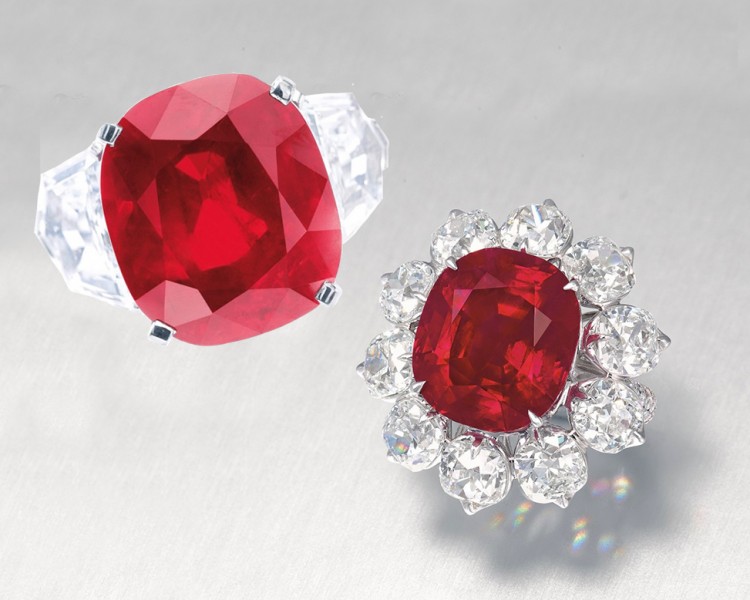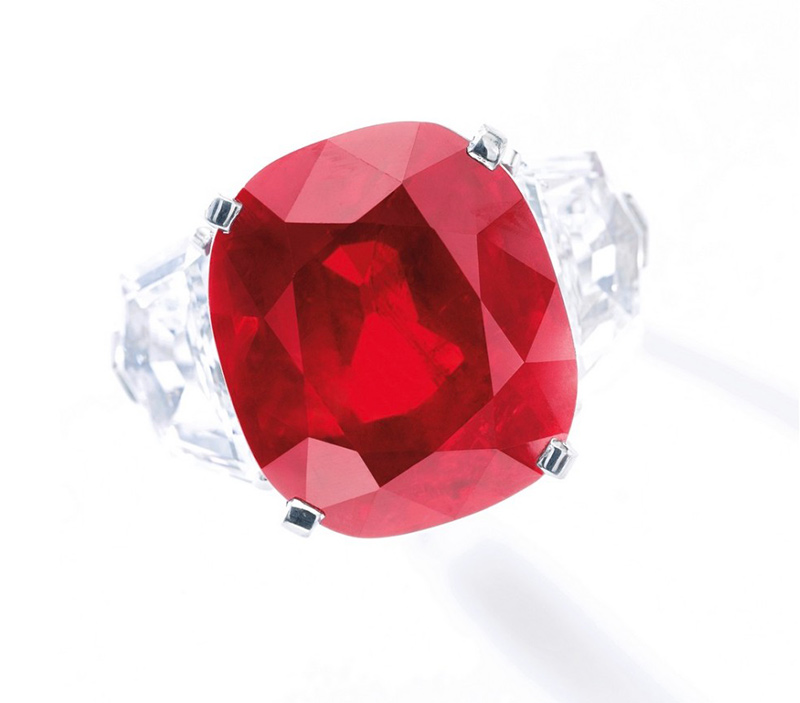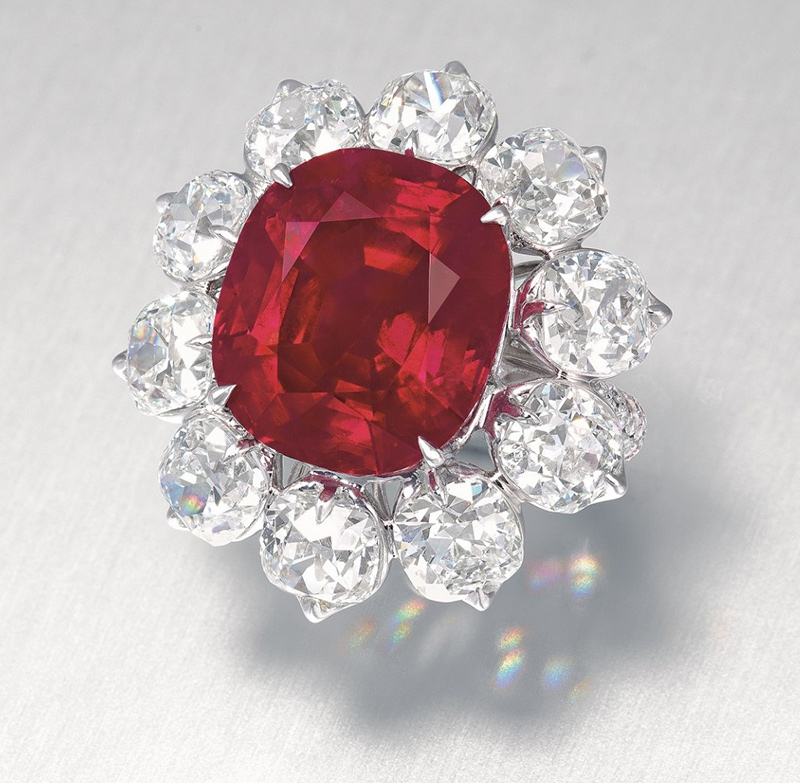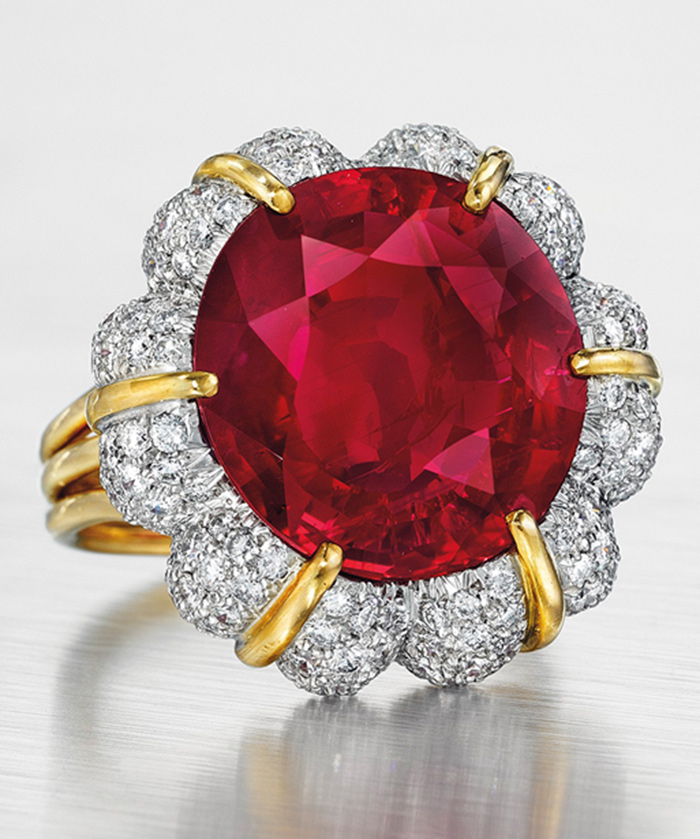
The Problem with Pigeon’s Blood
Cynics say that history exists to be ignored. Therefore, they argue, it has no choice but to keep repeating itself. What’s more, they’ll tell you no sphere of human activity is immune from history’s sad, stubborn rule of recurrence–even the jewelry industry.
They have a point. Dire repetition of the past seems hard at work in the world ruby market where expensive stones are increasingly unsalable without gem lab reports. In this case, labs are asked to authenticate a ruby’s color as the most precious hue of all: “pigeon’s-blood red.” No pedigree, no purchase.

This proliferation of reports certifying that stones exhibit “pigeon’s blood red” marks the second great paper chase for lab documents in 35 years. In 1979, American Gemological Laboratories introduced the first-ever colored stone grading reports. Using a 1.0 to 10.0 numerical color rating scale, fine rubies were expected to have grades of 3.5 on that scale to qualify for top color-excellence. The trouble was that the lab criteria for ideal red in rubies favored a purity-of-red approach that did not fit long-established standards for ideal ruby color. Stones with highest amounts of primary red often fared better than stones with preferred secondaries of orange or pink. When the market wised up to the fact that an artificial standard of color evaluation had been imposed on it, the certificate ruby market collapsed and prices for stones with ‘ideal’ color ratings plunged. By late 1981, stones that had commanded $5,000 per carat were lucky to fetch $500 per carat.
Could the same thing happen today as more and more rubies become eligible for the world’s most coveted color-descriptive term, and the category crowds with stones that are “pigeon’s-blood red” in name only?
The second certificate ruby market bubble is bigger and if it explodes, the damage may be far worse. Already dealers, gemologists and journalists I talked to are sounding red alerts. “If I said I have seen 25 rubies which truly deserved to be called ‘pigeon’s blood’ since I became a ruby and sapphire specialist in 1979, I am sure I would be making an overstatement,” says Jack Abraham, Precious Gem Resources, New York. “Now people regularly come to my office with stones certified as ‘pigeon’s blood’ that are such in name only. How, in less than a decade, did this term become a gem-marketing generality?”
Last June, at the JCK Show in Las Vegas, gem market analyst Stuart Robertson, research director of Gem World International’s Gem Guide, inspected 550 rubies for sale there. Ninety per cent of them had gemological reports describing their color as “pigeon’s-blood red.” Of these, at least 60 per cent were from well-known labs, including GIA. “Prices for these so-called ‘pigeon’s-blood red’ rubies ranged from $500 to $50,000 per carat,” Robertson says. “There is simply no way so many stones could deserve this designation.”

Show Me Your Papers
The rebirth of Pigeon’s Blood began with Adi Perretti in 1998, when his Bangkok-based GRS Lab started issuing reports for corundum that expanded the eligibility of rubies for the prized designation of “pigeon’s-blood red” to stones regardless of place of origin. “It is not reasonable to disqualify mining areas based on a color grading system, which only allows for those with a traditional heritage (e.g. ‘pigeon’s blood’ label only granted from Burmese rubies),” Perretti states on his website.
To many in the trade, Perretti’s decision to make rubies from every mining source eligible for a “pigeon’s blood” color report addresses a long-standing favoritism toward Burmese material. Rubies from Burma’s legendary Mogok tract have long commanded an origin premium. In recent years, however, the Burma mystique has been clouded by discovery of a second major ruby deposit at Mong Hsu whose material is generally of far lower quality. In the meantime, stones from Mozambique are said to rival Mogok’s in color. “Should Africa be penalized as a latecomer to the ranks of suppliers of magnificent rubies?” one dealer asked me.
When other labs followed Peretti’s lead and began using “pigeon’s blood” on ruby reports, buyers began demanding rubies with this designation. Almost overnight, the term “pigeon’s blood” became the sole synonym for superlative ruby color–the same way “D-color” for diamonds and “3.5 (or better) color” for rubies became the sine qua non ratings for these gems in 1980. Today, “pigeon’s blood” is the key ruby-branding catchphrase, as ubiquitous on lab reports as “No GMOs” labels are on food packaging. Several dealers complained to me that fine rubies cannot be sold if they are not accompanied by papers certifying them as “pigeon’s-blood red.”
The reliance–some would say, over-reliance–on broad classifications like “pigeon’s-blood” for ruby and “royal blue” for sapphire gives new stature to gem lab reports for colored stones and new power to the labs that issue them. Could this elevation of importance for poetic terms prove as problematic as the elevation of number and letter grades in the past? Abraham thinks the risks are greater. “I can see the need for a colored stone grading scale based on numbers,” Abraham concedes. “But how do you make a subjective term like “pigeon’s blood” into an objective rating? I’m not aware of any attempt beforehand to standardize the meaning of the term and translate it into meaningful color coordinates.”
Robertson thinks that such concordance between labs will be the next step toward validating widespread use of “pigeon’s blood.” Already, he notes, that the international Lab Manual Harmonization Committee, whose seven members include GIA, the Gubelin Gem Lab and the Swiss Gemmological Institute (SSEF), have standardized nomenclature for padparadscha sapphire and Paraiba tourmaline in 2011 and 2012 respectively. But will they do so for ruby?
It is less likely since many labs have already adopted their own standards–and they are vastly divergent. Although Gubelin and SSEF recently announced a uniform standard for stones deserving of the “pigeon’s blood” label, their requirements are far stricter than anyone else’s. The two Swiss labs confine use of the term to untreated stones of Burmese origin, recognizing the traditional associations of the term. On the other hand, GRS, the first and still the leading issuer of “pigeon’s-blood” ruby reports, bases their determinations solely on stone color, regardless of origin, and refuses to restrict usage of the term to stones that are untreated and are of any specific origin. GIA is also as liberal in its use of the designation, restricting mention of it to a comments section on its report. There it acknowledges that the stone’s color corresponds to the meaning of the common trade term, “pigeon’s blood.” Of all the major labs, only AGL refrains from using the term on its reports–reserving reference to the term for special detailed addendums that make the case for its relevance to the stone at hand.
Author-gemologist Joel Arem says he is sympathetic to Perretti’s attempt to democratize standards of beauty for ruby but the effort is doomed to fail. “If, after millennia of mining, Burma has yet to be dethroned as the world’s greatest ruby source, it could be argued that true-Burma stones deserve a premium just for being from there. Unfortunately, this premium is based on the general mystique of the locality and its historical provenance, not on the specific quality of the stones it produces. Face it, not all Burmese rubies are top color; many are pinkish or display a shade of red that experts would not all consider to be ‘pigeon’s blood’. If we recognize that ‘pigeon’s blood’ is a color designation, then Perretti is correct in disassociating the term from any specific point of origin.”

The French Connection
Is there a way to blend the exclusivist approach of traditionalists with the inclusivist approach of gem reformers? This writer thinks there is but it will take unprecedented cooperation and will power. I tried my idea out on Joel Arem and he has helped me to shape it into a proposal.
Put simply, our idea involves thinking of “pigeon’s blood” and terms like it that have come to epitomize the finest of their species in a new way. Instead of making them broad generic terms, we propose narrowing them to specific “appellations,” just as the French have done for most of their wines and cheeses since the mid-1930s.
This process would begin by forging international agreement between gem labs and dealer trade groups on specific geographic regions which have become identified with mining of the finest gems of a certain species. Just as wine-terms like “Champagne” and “Bordeaux” refer to specific regions, the right to use these terms also involves commitment to standards of production, including use of certain grape varieties. Might not this geographical approach be harnessed for gems?
Take ruby. For centuries, the Mogok stone tract in Burma has been considered the zenith of high-quality ruby production. Instead of using a subjective term like “pigeon’s blood,” perhaps the appellation “Mogok top red” might be adopted for the finest stones of proven extraction from that region. Of course, Mogok origin alone would not entitle a stone to this designation. It would also have to meet certain agreed-upon quality standards (including ones forbidding or limiting the use of treatments). If other regions emerge as regular producers of exemplary ruby, and their color bears close similarity to Mogok’s (or sets new standards), then a system of secondary “geo-gemological” appellations could be devised for these stones. But ideally, any specific color designation should be supported by objectively determined instrumental measurements that are both consistent and repeatable.
Don’t laugh. Such a system of appellations could be developed as well as enforced. Let’s return to wines. Although America produces champagne, the states in which they are produced are clearly marked on bottles. It is understood that the stand-alone term “Champagne” belongs to France. Nevertheless, many people buy California champagnes as much for preference as price. But the California winegrowers risk lawsuits and fines if they dare to use the word “Champagne” without a close-proximity disclosure of California origin.
One big reason the French have been so successful in defending the use of region-based wine-terms is that they are no longer mere words. They have become strictly regulated legal designations. As appellations, they have the force of law and have acquired strong French provenance over the years.
In the case of the jewelry industry, things are reversed. Geographical provenance has already been acquired for Burma rubies, Kashmir sapphires and Colombian emeralds. Now that provenance needs the defense of quality standards that are widely understood, respected and defended. “In an era of frequent global summits on climate and trade treaties, would it be that hard for the jewelry industry to erect a system of tightly controlled designations that recognize the special status of certain gems?” Arem asks.
He answers in the positive. “The art world recognizes the special status of certain painters. The high prices attached to their work has evolved over time, and has varied both historically and culturally. But these current stratospheric values are the result of a consensus within an extremely specialized marketplace that has ‘fine tuned’ its own standards for excellence, and has demonstrated the validity of its decisions in the brute-force arena of marketplace competition.
“Well, nature produces masterpieces, too,” Arem continues. “Appellations would be a way of letting the world know that gem experts and aficionados recognize the uniqueness and rarity of fine gems from specific localities, just as an original art masterpiece is vastly more desirable and valuable than any copy, no matter how well it is executed. The locality debate has already started in the case of Paraiba tourmaline and ‘Paraiba-type’ tourmaline from other localities, such as Mozambique and Nigeria. So there is ample current precedent for clearly separating the market values attached specifically to color, versus point of origin. Perhaps this approach will assist in identifying exactly which attributes of a gemstone contribute to its value, and allow buyers to get a better handle on what they are actually paying for!”

I hope some expert will give an update on this topic of color standardization…this is from 2016…please consider an update…
I purchased a ring which the seller listed it as a garnet, when I seen it I knew they were ruby’s. So I had it tested, definitely ruby’s 100%. Not only that the jeweler told me they were unheated pigeon blood ruby’s. It an old ring very unique. I’d like to know the steps to take to get the ring evaluated. Or if i can send a photo to see if you believe its worth doing so . I truly believe its a gem. Thank you
My name Juaquin have 5.8cararts piegon blood n other is bout 2 carat 5.0 pinkish ruby like to see what I could get for them
I have noticed you don’t monetize gemobsessed.com, don’t waste your traffic, you can earn additional bucks every month with new monetization method.
This is the best adsense alternative for any type of website (they approve all websites), for more info simply search in gooogle:
murgrabia’s tools
having gemstone of high value sometimes are being disregard when it came from a place not so familiar or famous in having it. Even if I uploaded my stuff in you tube or tag# laboratories and gem company still i end up with no attention. I have 881 grams of carbonado or what they called black diamond or it could be a new kind of gemstone it is polycrystalline. Whit my sincerity to my item as something of scientific value as well please see it in Asia Reveal where i uploaded some small part of 881 grams (4,405 carats). i had investigated its matrix, inclusions, c olor that confuses me why it appears dark blue in light and ray blue. I looked at scientific journal and made my observation to it but still needed help or advise of real expert to it. Thanks.
what if you do not know the history of a piece of jewelry but you know it was found with ww2 metals for marksman . a piece so breath taking you cant take your eyes off them .. a tie pin with 3 roses around 3 raw blood rubies in a line on hand made Gold filigree on a tie pin the size of penny . my father was a rock hound and collector of gem stones .. I have never seen any rubies better then these are and yes I have been to Thailand my self . I have never shown them to the out side world .. but I am getting old and they should be in a museum some where …where everyone can enjoy them , but I cant show them on the web . they will go off the charts ,when you see them you will know why I said that …” they may be the finest rubies in world ” to die for .. how they ended up in that marksmen’s war metals we may never know .. but the beautiful Jewish workmanship pales to nothing when the eye focuses on stones like these 3 rare bloody roses ! you want to just cry after you put them away ….they pull at the soul just wanting you to come back to them ….I don’t know what to do with them ….some one took their life savings and had them made into this tie pin … so they could flee the death of war …yet here with the metals they lay still waiting for me to set them free … these are real blood Rubies and yes I am a vet and I this in my heart ….I was going to just put them in my fathers grave . but he would have kick my ass …I think I will make a video and post it on you tube …name it ” the blood roses “
Have 381 Carat Iolite for Sale. Have certified papers, true ID.
Have BB size ganets with a purplei ish color. Gemmy.
Will sell, but not to give away.
86 yr ole Digger. All beautiful,, address gets you pictures.
Personally dug all gems.
Ted
Hello Ted,
I am approaching my 40th Anniversary and i am looking for a ruby for my wife.
i was reading your post and thought i would just give a reply. Dont know if you are selling them altogether
but i would only be interested in 1.
thank you for your time
Kevin Tubb
Please mention distinctive feature of Mogok ruby.
I’m an 84 yr. ole gent. Been Gem hunting for 9-10 yrs. Have a beautiful Blue 479.5 Carat Iolite. Read that David Federman was buying large Iolite over 5 carats? This one is a beautiful sky Blue, no fractures, Have certified papers on it.
Have many Pidgeon Blood, to lite Pink. Also Beautiful Rare Green Chrom. Diopside. These gems are gemmy & rare. These small in size/
Have many, clear to lt.green ( 8.0 moh’s, Hardness ) 30 carats up to over 500 carats. Most are Celery to Granny apple in color. Not sure
yet on Identify.
Also others .
Have not sold nor traded any. Would like to sell to David Federman.
Thanks for the post.
Ted
i have noticed so many different colours of pigeon blood rubies stones that i am also confused sometimes that really which one is real pigeon blood colour.so to amend this needs attention.
But i dont agree that only burmese rubies should be given this term and not to others . Because in a lab report when they give pigeon blood also mentions the origin of the stone so the buyer knows which stone to buy .some of them specifically demands burmese pigeon blood so they have a choice .
Pigeon blood is a term for colour so it should not only associate with burmese origin rubies
Thanks
David,
David Federman has written intelligent and timely articles on colored gemstones for decades. This is another well researched in depth article on a controversial aspect of the colored gemstone industry that is timely and accurate. Thank You David Federman again.
Sorry here’s a link to my take on Pigeon’s Blood.
Richard
Yo David,
Glad to see you are still out there. I think your solution to the ruby color problem needs a bit of work. Take a look at mine.
Richard